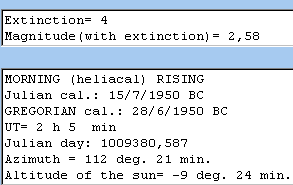This page hosted by
 Get your own Free Homepage
Get your own Free Homepage
Heliacal rising of Sirius in Thebes
The results which are shown here are given by a personal software working in JavaScript from data found in "Sky Catalogue 2000.0". It enables, for instance, to determine the time when a star becomes visible again in the morning after its period of invisibility (heliacal rising). You can yourself compute the date of this kind of phenomenon with the help of this JavaScript program . Be so kind as to e-mail me if you find bugs in this software.
I far prefer the gregorian calendar but I have added -for the historian's pleasure- the corresponding date of the julian calendar.
 Altitude of Sirius = 2°
Altitude of Sirius = 2°
- I assume that the star could be observed during the nautical twilight (sun between 6 and 12 degrees under the horizon). If my calculations are correct, the sun was between 9° and 10° under the horizon when the Egyptians observed the heliacal rising of Sirius, in low Egypt, in the end of the third Sothic cycle ( july 21st 139 AD -Julian calendar- ). This date is mentioned by Paul Couderc in "Le calendrier".
- The julian day is the number of days which have gone by since january 1st 4713 BC (Julian calendar) at 12 o'clock UT.
For completion'sake, I will add that, in 1951 BC (-1950), the sun reached the solstitial point on july 24th -Gregorian calendar- which corresponds to july 11th in the julian calendar.
In -1950, the heliacal rising of Sirius should therefore have taken place, in Thebes, four days after the solstice.
The following table describes the heliacal rising of Sirius between -2500 and -1500 at the latitude of Thebes.

The data in relation with the julian calendar are printed in blue. Those about the gregorian calendar are printed in red.
As you can see, the heliacal rising of Sirius is, in the julian calendar, unwedged by only one day in a millenary. This so called fixity must not hide the truth for it's only the result of the added action of two displacements which - it's a perfect hazard - make up for each other.
- The displacement of the julian calendar in connection with the seasons (and therefore with the gregorian calendar).
- The displacement of the heliacal rising in connection with the solstice owing to the precession of the equinoxes.
Return to main page
Return to previous page
 Altitude of Sirius = 2°
Altitude of Sirius = 2°
